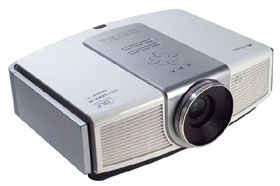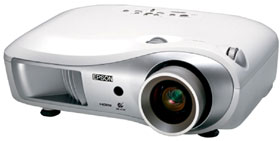 |
; |
CONS
|
BenQ W5000 Highlights:
|
Epson 1080 Highlights:
|
| MSRP: $3,400.00 Street Price: $2,700.00 |
MSRP: $2,650.00 Street Price: $2,500.00 |
| Manufacturer: www.benq.com | Manufacturer: www.epson.com |
Everybody likes a good one-on-one, mano e mano fight. And when both of the respective combatants appear – on paper anyway – to be evenly matched, the stakes are even higher, as is the subsequent anticipation. In this particular ring that plays host to home theatre, video projector battle, two such willing and able warriors, the Epson Home Cinema 1080 and the BenQ W5000, will go head to head in a showdown that promises to be a fight to the finish.
FIRST IMPRESSIONS – Epson 1080 vs. BenQ W5000
Style & Appearance
Of all the respective categories which are to follow, this one here is in many ways the most subjective of the bunch. What I may like style and design-wise, may not be your particular brand of goodness, and vice-versa. But in the interests of this piece, I can’t simply defer to subjectivity and call it a draw; so here goes.
When it comes to styling and looks, both units look really nice and modern, offering a happy dose of furniture value to any room in the house. Both projectors also come in a pearl white color case (of sorts) with silver accents, though the W5000 has more of a metallic, shiny-type of finish to it. So far, so even, but when you start to really dig deep down to your superficial core, you (in this case, I) begin to lean towards asking the Epson 1080 out for some coffee and pie. Those shapely, rounded contours get me every single time, offering that double-take head jerk that you don’t quite get with the W5000, and that proves to be just enough to nudge my interests – however slight – towards the Epson 1080. From a size and weight standpoint, the Epson 1080 LCD projector proves to be a little less bulky than its W5000 DLP counterpart (12.3 pounds as compared to 21 pounds, and 16 x 12.2 x 4.9 inches versus 19.4 x 7.1 x 16.5 inches), offering the added benefit of portability. In fairness though, both units are home theater projectors, so portability is by no means mandatory, as you’re quite likely to set your projector up once and not really have to move it around too much. Further, at 21 pounds, we can’t exactly dub the W5000 DLP projector an over-bloated heffer, only that the Epson 1080 just happens to be lighter.
Getting Connected
From a connectivity POV, both units are armed and ready for all your HD and gaming needs, offering inputs for HDMI, Component, S-Video, and Composite connections, all of which are nicely laid out and clearly labeled for you. The differences are that the Epson 1080 gives you an Analog RGB (PC) input, while the BenQ W5000 offers an additional HDMI input. Both variations are a matter of preference, and it’s hard to really favor one over the other, although for me, the more HDMI inputs you have, the better.
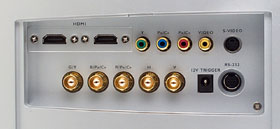 |
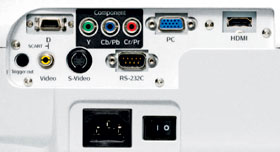 |
| BenQ W5000 | Epson 1080 |
Remote Control
In terms of remote controls, Epson and BenQ offer a stylish design to match their projectors. While they both feel ergonomically comfy in your hands, BenQ’s remote control seems a tad longer than it needs to be. Both of them also feature a handy backlight, but where one (Epson 1080) find the right balance between bright and easy on the eyes, the other (BenQ W5000) comes off as just a tad too overzealous in the lighting department. But for those that like things bright and shiny, the W5000 remote control may be just what you want for that pitch black, home theater environment. In terms of functionality, both score high marks across the board, offering one-touch button access to projector features like input sources, user-stored settings, aspect ratio, and contrast. Where they diverge somewhat is that the BenQ gives you button access to additional picture settings like brightness, color, and tint, while the Epson offers up the ability to adjust image settings like gamma and color temperature.
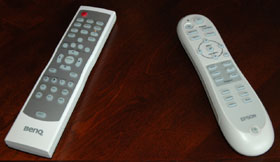 |
| (From Left To Right) BenQ W5000 Remote Control and Epson 1080 Remote Control |
PERFORMANCE – Epson 1080 vs. BenQ W5000
Set-Up
As I hinted at a little at earlier (size and weight), in terms of home theater usage, the Epson 1080 LCD projector can be further labeled a portable projector, while the BenQ W5000 DLP projector could be considered more of a fixed installation projector. I mention this very point because when it comes to setting up, the 1080 offers up a very flexible, short-throw lens (2.1:1), with a powered vertical (plus or minus 96%) and horizontal (plus or minus 47%) lens shift that can accommodate virtually any room or obstacle. In short: setting up the 1080 is a veritable cornucopia of ease and frustration-free simplicity. Alternately, the W5000 offers up a somewhat limited zoom lens (1.2:1), with only a powered vertical lens shift (plus 120% and minus 80%). For practical purposes, if you’re looking to project an image of about 100 inches in size, the Epson 1080 will demand about 10 feet of distance, while the BenQ W5000 will need at least 14 feet worth of clearance. Again, while the Epson does offer greater set-up flexibility than the BenQ, all of this is part and parcel to the nature of what they’ve been designed for, and for home theater purposes, chances are you'll have a fair amount of set-up space to play with.
Out-Of-Box Picture
Let’s now delve into the all-important area of picture quality. Here’s where we skirt the line and get into apples and oranges type of territory. The Epson 1080 utilizes LCD technology, while the BenQ W5000 is driven by DLP technology. Inherently, both technologies can be summed up as follows: LCD gives you that brighter, vivid, punchier look, while DLP tends to exude a warmer, richer, less “digital” look.
With many out-of-box projectors, you expect a less-than perfect image that requires some tweaking, but both Epson and BenQ have thankfully broken (or at least dented) that mold. That’s not to say that everything is peaches and cream, but it is to say that they’ve both stepped up admirably with a very fine image from the get-go. Both exhibited above-average contrast detail, although Epson had a slight edge when the scenes were noticeably brighter. While color-wise things were richer, if not a bit muted with the W5000, the 1080 had a bit more pop, likely due in no small part to good black levels, and particularly impressive white levels.
As always, you need to adjust your image settings by eye, based on your preferences and viewing environment. Both the Epson 1080 LCD projector and the BenQ W5000 DL projector offer you powerful, intuitive, and user-friendly menu controls. The W5000 responds quite well to these adjustments, improving contrast detail during even the brighter bits of scenery with blacker blacks and whiter whites. Color richness was also augmented with a snappier feel to it, more on par with what we tend to see with the better LCD projectors. On the Epson end of things, blacks were super deep and rich, and the whites were near perfect. This only enhanced the already impressive contrast detail. From a color gamut perspective, both projectors showed the great range that’s required to render different types of images in fine detail.
A point worth mentioning about both the BenQ W5000 and the Epson 1080 projectors while they're in use: if not for their projected images on your screen, you'd barely know they were actually in the room with you because they're so astoundingly quiet during operation. The BenQ W5000 DLP projector, in particular, is so quiet during usage that comparatively, a pin drop would sound like a bomb going off next to it. Very impressive stuff.
HD Images Comparison
| BenQ W5000 | Epson 1080 |
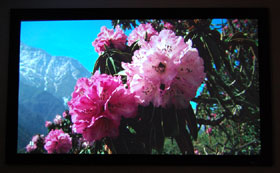 |
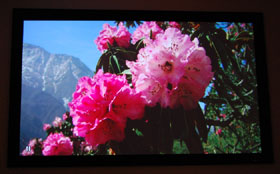 |
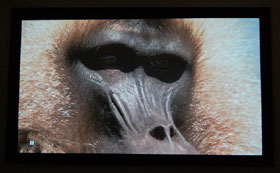 |
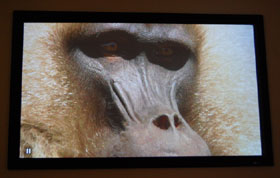 |
 |
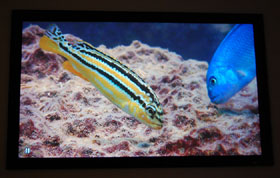 |
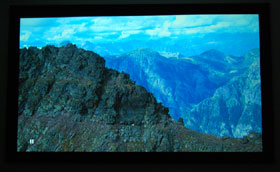 |
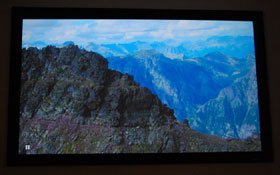 |
 |
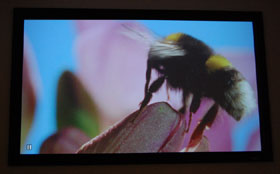 |
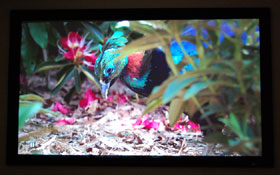 |
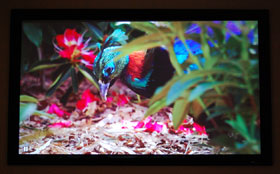 |
DVD Images Comparison
| BenQ W5000 | Epson 1080 |
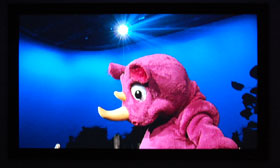 |
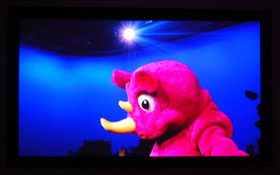 |
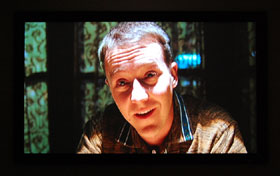 |
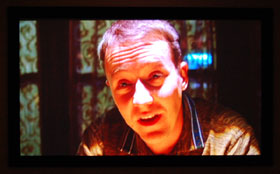 |
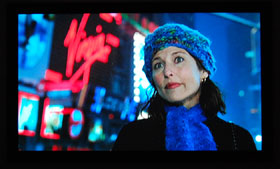 |
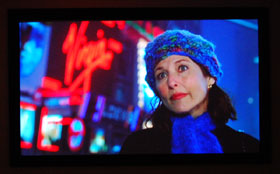 |
Calibration
From a calibrator’s point of view, the Epson 1080 and the BenQ W5000 proved to be a dream come true. The BenQ W5000 offers on-board, certified calibration controls care of ISF, while the Epson 1080 advanced display menu gives you all the RGB gain and offset options that you need, making calibration an ease. Interestingly, both units offer exceptional plug and play functionality as evidenced by just how close out-of-box, by eye image settings were with the calibrated ones. Additionally, both units favored a slight blue push (not uncommon with projectors as the human eye is far less sensitive to blue color frequencies), while white balance calibration on both ends – in the high and low IRE ranges – proved to be as simple and straightforward as it gets.
It’s never an easy thing to definitely recommend calibrating your projector or not. The benefits are usually quite subtle and nuanced that only the most critical and trained of eyes will tend to notice, and that proposition is only further complicated when you take into account how well the Epson 1080 and BenQ W5000 perform out of the box, and how much better they get just by simply adjusting a few things in the standard user menu.
FINAL THOUGHTS – Epson 1080 vs. BenQ W5000
Perhaps the best way to conclude this tight and hotly contested showdown is to use the trusty wine analogy referred to in the above title of this review. Do you like red wine? Or do you prefer white wine? Via this line of thinking, it’s not that one is “better” than the other, but rather, each has its respective advantages and disadvantages based on one’s own specific tastes. As such, I can only conclude one thing with absolute certainty: when it comes to your home theater, both the Epson 1080 LCD projector and the BenQ W5000 DLP projector are tremendous choices that offer maximum viewing pleasure and dynamic performance value. How and what you choose (or maybe you don’t and grab both) is ultimately dependant on whether red or white wine happens to tickle your particular fancy.
DETAILED SPECIFICATIONS - Comparison Chart
| FEATURES | BENQ W5000 | EPSON 1080 |
| Resolution | Native 1080p (1920 x 1080) | Native 1080p (1920 x 1080) |
| Contrast Ratio | Native 10,000:1 | Up to 12,000:1 (Dynamic Mode) |
| Brightness | Native 1200 ANSI lumens | Up to 1200 ANSI lumens (Dynamic Mode) |
| Display Type | Single-chip DLP Technology / Texas Instruments | Epson C2Fine 3LCD Technology |
| Inputs | Analog RGB:BNC x 5 (shared), HDMI 1.2 (with HDCP) x 2, Composite Video:RCA x 1, S-Video:Mini DIN 4 pin x 1, Component Video 1:RCA x 1, Component Video 2:BNC x 1 (shared) | HDMI 1.3 x 1, 3 RCA (Component) x 1, 1 RCA (Composite) x 1, 1 Mini Din (S-video) x 1, 1 Mini D-Sub 9 pin (RS-232c) x 1, 1 Mini D-Sub 15 pin (Analog RGB) x 1, D4/SCART x 1 |
| Projection Method | Front / Rear / Ceiling Mount | Front / Rear / Ceiling Mount |
| Projection Lens | F=2.4-2.7 f=38.9mm (wide) – 46.6 (tele) mm, Vertical + 120 to -80 | F-number 2.0 – 3.17 |
| Zoom Ratio | 1.2:1 | 2.1:1 |
| Image Size | 40 to 300 inches | 30 to 300 inches |
| Throw Ratio | 98 inches @4m (98 inches @13.12 feet) | 100 inches @3m (100 inches @9.8 feet) |
| Aspect Ratio | (5) Anamorphic, 4:3, Wide, Letter Box, Real | (4) Normal, Full, Zoom, Wide |
| Video Compatibility | NTSC, PAL, SECAM | NTSC, NTSC4.43, PAL, M-PAL, N-PAL, PAL60, SECAM |
| Picture Preset Modes | (6) Cinema Mode, Dynamic Mode, Standard Mode, User 1 Mode, User 2 Mode, User 3 Mode | (6) Dynamic, Living Room, Natural, Theater, Theater Black 1, Theater Black 2 |
| Password Protection | Yes | No |
| Accessories | User's Manual, Safety Manual, Remote Control, Batteries, Micro Dust Filter (2), Power Cords, Component Cable | User's Manual (CD only), Remote Control, Batteries, Power Cord, Computer VGA Cable |
| Lamp | 200W lamp, 2000/3000 hours (Normal/Economic mode) | 170W UHE E-TORL lamp, 1700 to 3000 hours |
| Operational Noise | 28/25 dB (Normal/Economic mode) | 26 to 33 dB |
| Power Consumption | Max. 340W | 120V Lamp On: 245W (lamp high), 200W (lamp low) |
| Dimensions (WxHxD) | 19.4 x 7.1 x 16.5 inches (492 x 180 x 420 mm) |
16 x 4.9 x 12.2 inches (406 x 124 x 309 mm) |
| Weight | 21 lbs (9.6 kg) | 12.3 lbs (5.6 kgs) |
| Warranty | One-year (parts & labor), lamp guaranteed for 90 days or 500 hrs from the purchase date | Two-year quick exchange warranty (includes priority, toll-free, technical support), plus 90-day lamp warranty |
All HD images used are from BBC's Planet Earth with a Sony PS3 for HD, Blu-ray playback, via an HDMI connection, 1080p output, using a Nikon D40 camera, and the Draper 106-Inch HD Onyx Gray Screen.
All DVD images used are from Death to Smoochy with a Pioneer 400 for DVD playback, via an HDMI connection, 480p output, using a Nikon D40 camera, and the Draper 106-Inch HD Onyx Gray Screen.
JVC DLA-X30 Review
Boxlight Pro7501dp
Panasonic PT-AE4000U
Mitsubishi HC4000 Review
JVC DLA-HD250 Review
HC3800 vs 8100
JVC DLA-HD550
Boxlight Projectowrite2
Epson 8100 Review
Epson 8500UB
Boxlight MP65E
Home • Projector Brands • Video Projector Reviews • Projector Resources • Contact Us
Archive Table of Contents 1
Archive Table of Contents 2
© Copyright 2016 Avdeals 3senses. All Rights Reserved.
